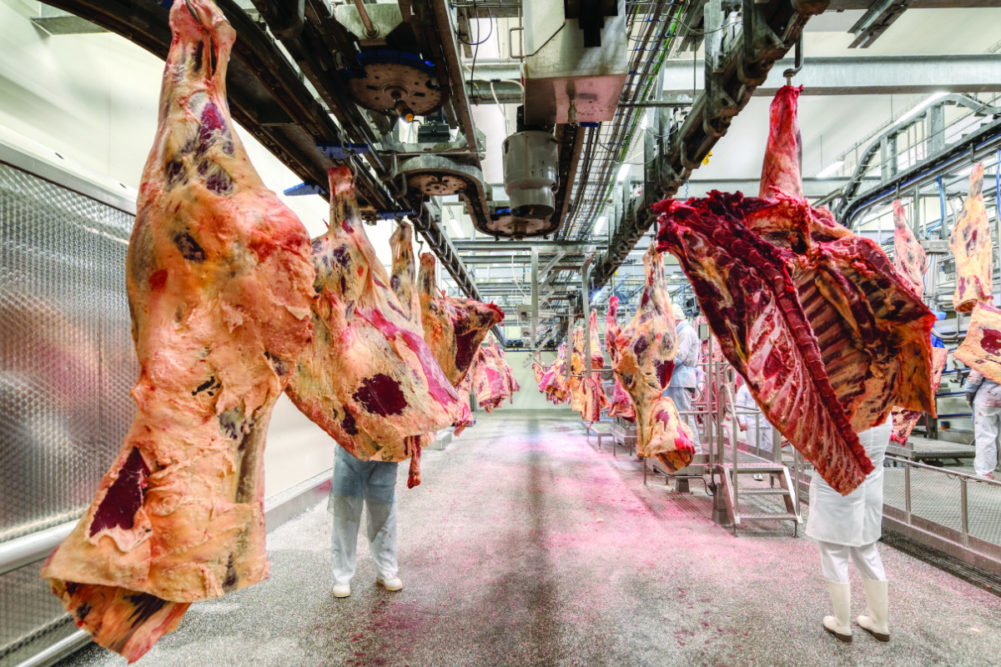DENVER, COLO. – The US Department of Agriculture and Agriculture Secretary Tom Vilsack announced a new pilot program on Jan. 19 designed to access markets for more cattle producers and meat processors.
The Remote Grading Pilot for Beef developed by the agency’s Agricultural Marketing Service (AMS) will allow a USDA grader to assess beef carcass characteristics and assign the official quality grade from a remote location to reduce costs and other barriers to participation in voluntary grading services.
Vilsack announced the new program at the National Western Stock Show in Denver, Colo., during a panel discussion with livestock producers and independent business owners.
“On average, a beef carcass that grades as USDA Prime is valued at hundreds of dollars more than an ungraded carcass, but costs for this voluntary USDA service often prevents smaller scale processors and the farmers and ranchers they serve from using this valuable marketing tool,” Vilsack said. “This remote grading pilot opens the door for additional packers and processors to receive grading and certification services allowing them to access new, better, and more diverse marketing opportunities.”
The agency noted that consumers, as well as buyers and sellers of beef, rely on the USDA quality grades, Prime, Choice, and Select, for clear and standardized ways to indicate quality.
The USDA said it officially grades 90% of America’s beef supply but most users are large beef packing operations. The agency said meat grading and certification services are significantly underutilized by small, independent processors due in large part to the expense of paying for a USDA grader to travel to their facility to perform the service in person on a relatively small number of cattle that would not require a full day of the graders’ work.
“Experience with remote grading so far has shown it dramatically reduces travel-related expenses, which makes the service more accessible to smaller processors,” the USDA said.
While starting the pilot program, trained plant employees captured specific images of live animals and beef carcasses. The images are submitted electronically to a USDA grader already stationed elsewhere in the United States, who reviews the images and accompanying plant records and product data.
The grade can then be assigned the USDA Quality Grade and applicable carcass certification programs, and the official grade is sent back to the plant to be applied to the carcass.
USDA graders can review carcass images and assign a quality grade within 24 hours. The program specifies that remote grading can be used by small and mid-sized operations, limiting the number of carcasses a processor can present to 100 per week.
Once grading is complete, plants can then use the information in retail marketing and transmit carcass performance information back to producers.
Following the announcement, the US Cattlemen’s Association (USCA) came out in favor of this pilot program.
“Before today’s announcement, it was simply unaffordable for an independent producer or processor to participate in providing quality-graded beef to the marketplace,” said Patrick Robinette, USCA’s independent beef processing chairman. “Now, the producers I serve will be able to access value-added programs that were previously unavailable to them. With the free ribeye grid device that will be provided to participating processing facilities, independent producers and processors can qualify for programs like Certified Angus Beef.”
Robinette, a family owner of Micro Summit Processors, Micro, NC, stated that at his operation, the cost would have averaged $410 per head to receive grading services; with the pilot program, it would reduce the cost to $4.56 per head.
“USCA brought forward a producer pinch point in the marketplace and USDA provided a competitive and producer-driven solution, bringing a process developed in 1916 into the modern era,” Robinette said.
Chris Young, the executive director for the American Association of Meat Processors (AAMP), explained how the decision will help small processors around the country.
"AAMP is excited about the possibilities of the USDA Remote Grading Pilot Project," Young said. "This use of imaging technology should allow our small, independent processor members to utilize the grading services they may not have been able to obtain in the past. Small processors are producing high-quality beef, and the ability to market their products as Prime or Choice is a tremendous opportunity."
The National Cattlemen’s Beef Association (NCBA) also came out in favor of the program and how it could impact the cattle supply chain.
“The USDA quality grades of Prime, Choice and Select are instantly recognized by consumers and an important way for cattle producers to be rewarded for raising high-quality beef,” said Ethan Lane, vice president of government affairs for NCBA. “NCBA is glad that USDA is launching this Remote Grading Pilot Program and expanding opportunities for meat grading to occur in smaller, local processing facilities. This will increase marketing opportunities for cattle producers and help them capture more value from their product.”
AMS held a feasibility study of a “remote grading” process conducted during the second half of 2023.
Through the pilot, AMS will gather additional information on actual cost and the level of in-person surveillance needed to ensure program consistency and integrity to formalize this innovative service option as part of the USDA Quality Grading Service. The agency plans to expand its testing by engaging a larger and more diverse number of beef packers to participate in the development of this procedure.
The program is limited to domestic beef slaughter facilities that operate under federal inspection and produce products that meet the eligibility criteria for USDA grading.



